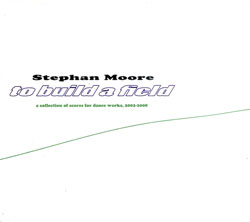
A collection of scores for dance works, especially in the electronic field (think Twyla Tharp and David Byrne's The Catherine Wheel) usually pricks up my ears, and Stephan Moore's To Build A Field is no exception. How dancers would gyrate to the minimal blips, splayed chords, deep resonances and broad-stroke atmospheres abundant throughout these six pieces is anyone's guess (and surely must have been something to behold), but they sure work splendidly in the home listening environment as they tumble out of your speakers.
"Transmission" almost plays like a Raster-Noton creation, its bent pitches, occasional bursts of static and glitch, and Sakamoto-esque synth drones on par with virtually anything Carsten Nicolai's imprint has released these past few years — emotionally tense and tactile, its humble textures make for some extraordinarily vibrant stuff. "Bell, Wind, Fuse" trades the former's alien climes for more weathered, acoustic sound-sculpting, Moore erecting loops of bell decay and xylophone thrums in a herky-jerky fashion that eventually achieves a sort of lopsided, stop/start rhythmic undertow, a real equilibrium-upsetter that must have been hell to choreograph. "Wick" returns to the pale electronics of "Transmission", augmented by weird background stutters and muted bursts of crackly machine detritus, a hauntological refrain of digital billows and laptop clank. "Comae" revisits the second piece's improvisational quarters, replete with samples that are chopped, cut-up and reintegrated in classic Burroughs-ian fashion, a carnival of half-glimpsed sonic memories embroidered with merry accidents, happy errors, the glee of false starts repaired by the omniscient power of ProTools.
As a piece, To Build A Feel treads through a veritable history of late 20th century electronic and experimental genres, both sonic portraiture on display for all to see and a tidy summation of what has gone and what can still be accomplished by determination and no little amount of personal grit. A work such as "Escalation" rewards the listener on more levels than simply the visceral; it is an exercise in transcendent melancholy, eclipsing Master Eno's similarly stoked early ambient trials. And the closing "Dream Tango" even recalls some of the Teutonic pioneers (Tangerine Dream, Klaus Schulze, early Kraftwerk) who share its sparkling trills and delightfully nostalgic tonal bleeps, as Moore and company dance under the Moog-lit night.
Comments and Feedback:
|



